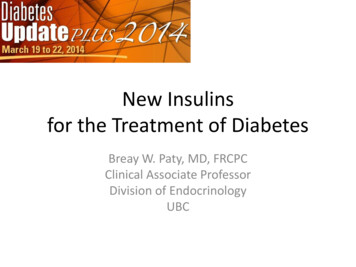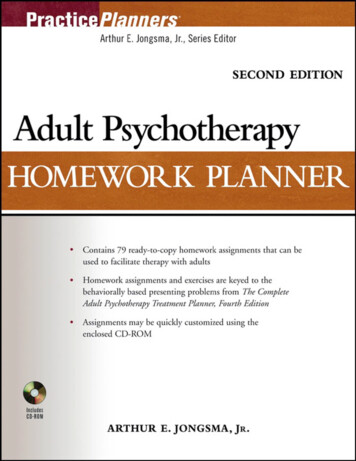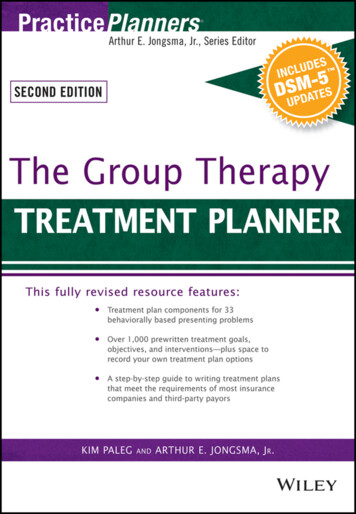
Transcription
New Insulinsfor the Treatment of DiabetesBreay W. Paty, MD, FRCPCClinical Associate ProfessorDivision of EndocrinologyUBC
Learning Objectives Review currently available insulin preparationsand basal-bolus concept of insulin delivery Update new and investigational Basal insulins Update new and investigational Bolus insulins Summarize alternative insulin delivery methods
Human InsulinLysPro51 amino acids with a molecular weight of 5808 Da
Insulin(µU/mL)Physiologic Insulin Secretion :Basal/Bolus Concept50Prandial InsulinBasal:250Basal InsulinBreakfast LunchGlucose(mmol/L)8.3SupperSuppresses GlucoseProduction Between Meals& OvernightPrandial Glucose5.5Prandial:2.80Basal Glucose7 8 9 10 11 12 1 2 3 4 5 6 7 8 9A.M.P.M.Time of DayFacilitates glucose uptakeafter meals
Development of Novel Insulins
Basal – Bolus ConceptInsulin Effect Background insulin Mealtime insulinBLSHSB
Regular Insulin AbsorptionSubcutaneousTissuePassage of more associated forms through capillary membrane isrestricted due to steric hindranceBrange et al. Diabetes Care 1990;13:923–54
Biochemical associationaffects insulin absorptionSubcutaneous tissueMolecular size6 kDa36 kDa72 kDa 5000 kDaHigh molecular weightformsInsulinassociation stateAbsorption rateCapillary membraneRapid absorptionLimited absorptionSlow absorption
Insulin isineLisproAspartGlulisine
Insulin Profiles(aspart, lispro, glulisine)
BASAL INSULIN
Desired Properties of Basal Insulin Long duration (over 24 hours) Minimize injections (no more than 1/day) Flat pharmacokinetic profile (low variability)– reduced risk of hypoglycemia Flexible dosing Less weight gain
Current Basal Insulins Insulin glargine– pH-dependent solubility causing hexamer formation– precipitates upon injection into the subcutaneousspace followed by slow release– binds to albumin protracting its biological activity Insulin detemir– acylated insulin – C14 FA on position B29 results inprotracted biological activity through a combinationof self-association and albumin binding
New* Basal Insulins Degludec (Novo Nordisk)– Approved in the European Union, Mexico, Japan LY2605541 (PEG insulin Lispro) (Lilly/Boehringer)– Currently in Phase 3 Trials Concentrated insulins– U200 degludec, U300 glargine LY2963016 (Biosimilar Glargine)(Lilly/Boehringer)– Currently in Phase 3 Trials*Not yet available in Canada
Degludec molecular structureGlu dedecLysB29Nε-hexadecandioyl-γ-GludesB30 human insulinssG I V E Q C C T S I C S L Y Q L E N Y C NA chainssssF V N Q H L C G S H L V E A L Y L V C G E R G F F Y T P K TB chaindesB30 InsulinNHOL-g-GluOHOONHHexadecandioylOHO
Multi-hexamer formation after injection[Phenol;Zn2 ]Insulin degludec injectedPhenol from the vehiclediffuses quicklyDi-hexamers link up via singleside-chain contactsLong multi-hexamer chainsassemble
Following injectionSubcutaneousdepot[Zn2 ]Insulin degludecmulti-hexamersZinc diffuses slowlycausing individualhexamers todisassemble, releasingmonomersMonomers areabsorbed from thedepot into thecirculationover a period of hours
Insulin degludec multihexamersMain picture shows elongated Degludec structures in absence of phenol; inset (white box)shows absence of elongated Degludec structures in presence of phenol.Kurtzhals P et al. ADA 2011;32-LB (MoP NN1250-1993).
Terminal half-life of Degludec andGlargineDegludec doset½ (h)Glargine 27.023.911.814.011.9Mean t½ (h)Data are harmonic means.Heise T et al. ADA 2011;37-LB (NN1250-1993).25.412.5
Degludec Clamp profilein type 2 diabetesTreatmentDegludec 100 U/mL 0.4 U/kgDegludec 100 U/mL 0.8 U/kgGlucose infusion rate(mg/(kg*min))543210Nosek L et al. ADA 2011;49-LB (NN1250-1987).Degludec 100 U/mL 0.6 U/kg
A1C reductions in basal bolus studiesMean change in A1C at week 52Type 1 Basal Bolus0.0%n 472n 157-0.4%-0.4%Type 2 Basal Bolusn 744n 248Change in A1C (%)-0.2%-0.4%-0.6%-0.8%Degludec AspartIDeg IAspDegludec-Glargine treatment difference:-0.01% (95% CI -0.14, 0.11)Glargine AspartIGlar IAsp-1.0%-1.2%-1.4%-1.2%-1.3%Degludec-Glargine treatment difference:0.08% (95% CI -0.05, 0.21)Heller S et al. Lancet 2012;379:1489-97Garber A et al. Lancet 2012;379:1498-507
Basal bolus type 1:Confirmed nocturnal hypoglycemiaNocturnal confirmed hypoglycemia(cumulative events per patient)6.05.025% riskreduction,p 0.021Degludec OD (n 472)glargine OD (n 157)significant4.03.02.0PG 3.1 mmol/L*1.00.0048121620242632Time (weeks)SASComparisons: Estimates adjusted for multiple covariatesHeller S et al. Lancet 2012;379:1489-973640444852
Confirmed hypoglycemia(cumulative events per patient)Basal bolus type 2:Confirmed hypoglycemia16Degludec OD (n 753)glargine OD (n 251)141218% riskreduction,p 0.036significant1086PG 3.1 mmol/L*420048121620242832Time (weeks)SASComparisons: Estimates adjusted for multiple covariatesGarber A et al. Lancet 2012;379:1498-5073640444852
Nocturnal confirmed hypoglycemia(cumulative events per 100 patients)Basal bolus type 2:Confirmed nocturnal hypoglycemiaDegludec OD (n 753)glargine OD (n 251)25% riskreduction,p 0.04significantPG 3.1 mmol/L*Time (weeks)SASComparisons: Estimates adjusted for multiple covariatesGarber A et al. Lancet 2012;379:1498-507
SUMMARY OF ONCE-DAILY DEGLUDECCLINICAL TRIAL FINDINGSA1CBASAL/BOLUSsimilarFPGsimilar(type 2)BASAL/BOLUSsimilarsimilar(type 1)FLEX(type 2)similarsuperiorAll in comparison with insulin glargine.Red box indicates statistical cemia25% risk18% riskreduction withDegludec25% riskreduction withDegludectrend towardless withDegludecreduction withDegludecsimilarsimilar
Summary of Insulin Degludec vs GlargineEffects in Type 1 Patients over 104 Weeks Nocturnal hypoglycemia reduced by 25% Similar HbA1c lowering Similar fasting and 9-point self-measuredplasma glucose At study end lower insulin requirements– 12% less basal insulin– 9% less total daily insulin– 6% less bolus insulin
FDA: Degludec CV Safety Meta-analysisFDA Office of Translational Sciences Center for Drug Evaluation and Research IDeg/IDegAsp Cardiovascular Meta-AnalysisEndocrinologic and Metabolic Drugs Advisory Committee Meeting November 8, 2012
Degludec: Time to First MACE within 7 Days of TxPhase 3 Trials – Cox Regression – Forest PlotNovo NordiskInsulin Degludec NDA 203314 Insulin Degludec/Insulin Aspart NDA 203313, Endocrinologic and Metabolic DrugAdvisory Committee, November 8, 2012
FDA: Degludec CV Safety Meta-analysisFDA Office of Translational Sciences Center for Drug Evaluation and Research IDeg/IDegAsp Cardiovascular Meta-AnalysisEndocrinologic and Metabolic Drugs Advisory Committee Meeting November 8, 2012
FDA Decision November 2012: FDA Advisory Committee voted 8:4 tosupport marketing of degludec and degludec/aspart February 2013: Complete Response letter from FDA,requiring a dedicated cardiovascular outcomes trialbefore the review of the application could becompleted Cardiovascular outcomes trials underwayDEVOTE Trial – expected completion 2018
potential for less lipogenesis, increased lipidoxidation and weight loss
T1D Phase 2 LY2605541 vs. glargine:Study DesignScreeningRandomizationAdult (aged 18-65years)T1D 1 yearGlargine: ( 1.0U/kg/day) 6 monthsA1C 10.5%BMI 19-45 kg/m2End ofTreatmentTreatment CrossoverPeriod 1Period 2LY2605541LY2605541Insulin GlargineEnd ofStudyPrestudy insulin orother recommendedbasal insulinInsulin GlargineFollow-upPeriodWeek: -4 1-20181620Visit:PR2 3T610111 Phase 2, multinational, randomized, open-label, crossover, clinical trial Morning once-daily AM basal insulin (LY2605541 or GL) plus prandial insulin for 8 weeks, thenswitched to the other basal insulin for 8 weeksPrimary outcome measure: Daily mean blood glucose as measured by 8-point SMBG profiles during 8 weeks oftreatmentRosenstock et al. Diabetes Care 2012;(Epub Ahead of Print).
T1D Phase 2 LY2605541 vs. glargine:Glycemic Control at 8 WeeksMean BG SE (mmol/L)Mean BG SE (mmol/L)12Baseline (n 137)GL (n 130)LY2605541 (n 124)11109876FgtinsaAMPtprsodania lddMiPayree -mdMialydaPtprsodania leEvninrgPEvee -mealgninP***tprsodania lBemeitdM3ATime Point*p .01 after 8 weeks of LY2605541 treatment compared to GLRosenstock et al. Diabetes Care 2012;(Epub Ahead of Print).
T1D Phase 2 LY2605541 vs. GL: Rates of Totaland Nocturnal HypoglycemiaΔ 12%; p .037Δ -25%; p .012 Severe hypoglycemia incidence similar between groups (6 events with LY2605541[5 patients] and 6 events with glargine [3 patients])Rosenstock et al. Diabetes Care 2012;(Epub Ahead of Print).
T1D Phase 2 LY2605541 vs. glargine:Change in WeightMean Weight Throughout16-week Crossover StudyTreatmentPeriod 1LS Mean Change in Weight Over 8WeeksTreatmentPeriod 2p .0001Rosenstock et al. Diabetes Care 2012;(Epub Ahead of Print).
LY2605541 (PEG Lispro) Five ongoing Phase 3 IMAGINE trials in patientswith type 1 and type 2 diabetes, compared withcurrently available basal insulin analogs
Concentrated Insulinson the Horizon Glargine U300 contains 3 units in each 0.01 ml(or 1 unit mark on an insulin syringe) Degludec U200 contains 2 units in each 0.01ml (or 1 unit mark on an insulin syringe)U100U300
U300 Glargine: Pharmacodynamics BG levels stayed close to the clamp target until theend of clamp with 0.6 and 0.9 U.kg-1 U300U100 0.4 U.kg-1U300 0.4 U.kg-1U300 0.6 U.kg-1BG (mg.dL-1)*160SC INJECTIONU300 0.9 U.kg-1140CLAMP LEVEL 18 mg.dL-1 (mmol.L-1)120100CLAMP LEVEL061218Time (hour)*Smoothed(LOESS factor 0.15) 36-h BG profiles243036
EDITION I: severe or confirmed nocturnalhypoglycemia from month 3 to 6 (1st main 2 endpoint)21% reduction for Gargine U300 vs U100 (p 0.0045)Patients with 1 severe or confirmed( 70 mg/dL) nocturnal hypoglycemia frommonth 3 to 6 (%)5045403521%46.0%36.1%3025RR 0.79(95% CI 0.67 to 0.93)p 0.004520151050U300 (n 404)Nocturnal hypoglycemia defined as an event between 00:00 and 05:59mITT populationCI, confidence interval; mITT, modified intent to treat; RR, relative riskU100 (n 400)
Biosimilar Insulins What is a biosimilar?– biological product which is highly similar (but notnecessarily identical) to the reference product,notwithstanding minor differences in clinically inactivecomponents– there are no clinically meaningful differences between thebiological product and the reference product in terms ofthe safety, purity, and potency of the productHow close is close enough?
Global Core Areas for Biologics BillionsInternat J Pharm Tech Res July-Sept 2013; 5 (3):924-935.
Marketed Insulin Glargine Copies (Biosimilars)Status, brand nameMarketedBasalin Injectible form(U100/mL)3-mL cartridgesCompany(manufacturer)Gan & LeeCountry (year)China (2005)10-mL vialsBonglixan Glaritus Clinical studies,commentsCheng et al. (2010)Zhu et al. (2009)3-mL cartridgesEast West Pharma (Gan & Lee)Pakistan (2009)3-mL cartridges10-mL vials3-mL cartridgesLandsteiner Scientific (Gan & Lee)Mexico (2008)Wockhardt Ltd.India (2009)NANCT01357603 Phase INCT01352663 Phase IIIBasalog RegisteredGlaritus 3- and 10-mL vialsBioconIndia (2009)CTRI/2008/091/Phase III3-mL cartridgesPharmaris PeruPeru (2010)NABelmedpreparaty (Gan & Lee)Belarus (2011)NALaFranColColombia (2009)Disposable penSubmissionGlargin 10-mL vials3-mL cartridgesRejectedBasalin Injectible solutionOwens, et al. Diabetes Technol Ther. Nov 2012; 14(11): 989–996.INVIMA (2009)Dossier rejected: lackingimmunogenicity studies
Biosimilars Potential Advantages––––possibly different indications, regimens or delivery devicesimproved tolerance or pharmacokinetic (PK) profilefewer injections, less variability and longer shelf lifeexpected to be less expensive than the originalbiotherapies (but not as cheap as generics) Potential Disadvantages– Possible differences in biological activity, bioavailability,receptor binding, duration of action and side effectse.g. differences in the immune response, antigenicity– Differences in quality control– Relative paucity of large clinical trial data
Marjorie Shapiro, Ph.D. FDA Advisory Committee for Pharmaceutical Science and Clinical Pharmacology August 8, 2012
Biosimilar Glargine(LY2963016 – Eli Lilly/Boehringer) Same a.a. sequence as Lantus (insulin glargine)– Biological manufacturing process is different Jul. 2013 - European Medicines Agency (EMA) acceptsapplication for approval Dec. 22, 2013 – Lilly applies for FDA review Jan. 30, 2014 – Sanofi files for patent infringement– Possibly delaying introduction to NA until 2016
BOLUS INSULIN
Current Bolus Analogue Insulins Substitution of selected amino acids reducesinsulin molecule's tendency to form hexamersAspart – proline with aspartic acid at position B28Glulisine – glutamic acid with lysine at B29Lispro – switch lysine and proline at B28, B29 more rapidly absorbed compared to regularhuman insulin more flexible dosing for meals and activity
Ultra-rapid acting injectable insulins Chelated regular insulin (Biodel Linjeta)– Blocks hexamer formation Hyaluronidase insulin (Halozyme rHuPH20)– Increases dispersion/absorption of regular/rapidinsulin
Chelated Insulin (Linjeta ) * Regular human insulin (hasa zinc molecule surroundedby 6 insulin molecules) Added chelating agent(EDTA) to remove zinc Insulin no longer formshexamers Rapidly absorbed wheninjected Uses citric acid to bind tospecific areas on the insulinto prevent re-clustering*Phase 3 Clinical TrialsRemoval of zinc viaEDTA destabilizesthe insulin hexamer
Chelated Insulin (BIOD-200, 300, 400)Rasner, et al. J Diabetes Sci Technol 2012;6(4):786-796
Cumulative exposure and action of glulisine, lispro, andaspart after sc injection with and without rHuPH20 Time to 50% exposure decreased from about 2 hours for the analogsalone to 75 min when injected with rHuPH20 Early (first‐hour) exposure was doubled with rHuPH20 and halvedbeyond 2 h (all P 0.0001)Morrow, et al. Diabetes Care 36:273–275, 2013
Alternative Methods of Insulin Delivery Transdermal (632 Citations)Nasal Insulin (661 Citations)Sublingual Insulin (77 Citations)Buccal Insulin (132 Citations)Oral Insulin (24,599 Citations)Inhaled Insulin (983 Citations)Intraperitoneal Insulin (2660 Citations)
Transdermal Insulin Delivery
Transdermal InsulinLing et al. Acta Biomater. 2013 Nov;9(11):8952-61.
Oral Insulin Delivery Biocon IN-105“Biocon enters into an option agreement with Bristol-MyersSquibb for Biocon’s IN-105, an Oral insulin candidate” November 16, 2012 Oramed ORMD 0801“Oramed Receives Clearance to Initiate Oral Insulin Trials in the U.S.” May 17, 2013 Capsulin– Preparing for Phase IIb Under IND– Development, marketing and distribution license to leading oral diabetescompany in India NovoNordisk“Novo Nordisk’s Oral Insulin Successfully Completes Early Study” March 20, 2013– NNC0148-0000-0362: Phase 1 (Completed)– NNC0148-0000-0287: Phase 1 (Recruiting)– NNC0123-0000-0338: Phase 1 (Completed)– NNC0123-0000-0338 in Subjects With Type 2 Diabetes
Inhaled Insulin Delivery
Mannkind’s Technosphere (Afrezza )Recombinant HumanInsulin adsorbed onto fumaryldiketopiperazineTechnosphere pH 6 as TI Inhalation PowderpH 6 in the lungs
Technosphere (Afrezza ) inhaledinsulin powder Jan 19, 2011 – FDA Complete Response letter August 2013 – Affinity 1 and 2 Trial ResultsOpen-label study – 518 patients with type 1diabetes on basal/bolus insulin therapy24-week study randomized to:– Continuing on sc insulin aspart with basal insulin (170 pts);– Switching to AFREZZA with basal insulin (174 pts)
Afrezza : Affinity Trials (1 & 2) Over 24-weeks:– A1c levels decreased comparably in the AFREZZA-Gen2group (-0.21%) and the insulin aspart group (-0.40%) (p ns)– proportion of subjects achieving A1c target levels 7.0% or 6.5% was less in the AFREZZA-Gen2 group than in theinsulin aspart group– among patients who achieved A1c levels 7.0% and 6.5%,event rates for overall hypoglycemia were significantlylower in the AFREZZA-Gen2 group than in the insulin aspartgroup– AFREZZA-Gen2 group lost an average of 0.39 kg over thetreatment period compared to an average gain of 0.93 kg inthe insulin aspart group (p 0.0102)
New Insulins: Are they Better? Ultra-long-acting Basal insulins– Evidence of reduced nocturnal hypoglycemia and decreased weight gain atcomparable A1c lowering when compared with glargine– Larger phase 3 clinical trials needed to confirm hepatic and CV safety Ultra-rapid-acting Bolus insulins– Evidence for reduced postprandial hyperglycemia, and potential for moreconvenient dosing– Larger phase 2 3 trials underway to confirm efficacy, site tolerability andcardiovascular safety Non-injectible insulins– Pulmonary: Affinity 1 and 2 Trials– Oral: Phase 1 and 2 studies planned or ongoing Biosimilar insulins– Growing part of insulin market in many countries– questions remain regarding efficacy and safety
U300 Glargine: Pharmacodynamics BG levels stayed close to the clamp target until the end of clamp with 0.6 and 0.9 U.kg-1 U300 *Smoothed (LOESS factor 0.15) 36-h BG profiles Time (hour) 0 6 12 18 24 30 36 L-1) * 100 120 140 160 CLAMP LEVEL 18 mg.dL-1-(mmol.L 1) CLAMP LEVEL U100 0.4 U.kg-1 U300 0.4 U.kg-1 U300










